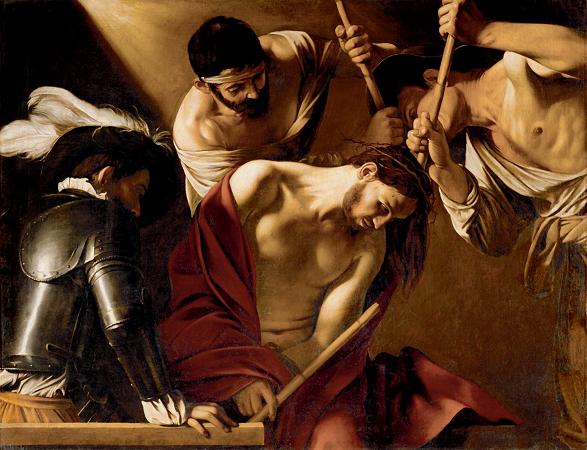Crown of Thorns. According to three of the Gospels, a woven crown of thorns was placed on the head of Jesus during the events leading up to the crucifixion of Jesus. It was one of the instruments of the Passion, employed by Jesus' captors both to cause him pain and to mock his claim of authority. It is mentioned in the gospels of Matthew, Mark and John and is often alluded to by the early Church Fathers, such as Clement of Alexandria, Origen and others. In later centuries, relics believed by many to be all or part of the Crown of Thorns have been venerated. For the first four centuries there was no extra-biblical mention of the crown of thorns. A few writers of the fifth and sixth centuries AD speak of a relic known to be still in existence and venerated by the faithful. St. Paulinus of Nola, writing after 409, refers to the thorns with which Our Saviour was crowned as relics held in honour along with the cross to which he was nailed and the pillar at which he was scourged. Cassiodorus, when commenting on Psalm lxxxvi, speaks of the crown of thorns among the other relics which are the glory of the earthly Jerusalem. There, he says, we may behold the thorny crown, which was only set upon the head of Our Redeemer in order that all the thorns of the world might be gathered together and broken. When Gregory of Tours in De gloria martyri avers that the thorns in the crown still looked green, a freshness which was miraculously renewed each day, he does not much strengthen the historical authenticity of a relic he had not seen, but the Breviary or Short Description of Jerusalem, and the itinerary of Antoninus of Piacenza clearly state that the crown of thorns was then shown in the Basilica of Mount Zion, although there is uncertainty about the actual site to which the authors refer. From these fragments of evidence and others of later date, it is likely that a purported crown of thorns was venerated at Jerusalem from the fifth century for several hundred years. Francois de Mely supposed that the whole crown was not transferred to Byzantium until about 1063. In any case Justinian is stated to have given a thorn to St. Germain, Bishop of Paris, which was long preserved at Saint-Germain-des-Pres, while the Empress Irene, in 798 or 802, sent Charlemagne several thorns which were deposited by him at Aachen. Eight of these are said to have been there at the consecration of the basilica of Aachen by Pope Leo III. The presence of the Pope at the consecration is a later legend, but the relics apparently were there, for the subsequent history of several of them can be traced without difficulty. Four were given to Saint-Corneille of Compiegne in 877 by Charles the Bald. Hugh the Great, Duke of the Franks, sent one to the Anglo-Saxon King Athelstan in 927, on the occasion of certain marriage negotiations, and it eventually found its way to Malmesbury Abbey. Another was presented to a Spanish princess about 1160 and again another was taken to Andechs Abbey in Germany in the year 1200. In 1238, Baldwin II, the Latin Emperor of Constantinople, anxious to obtain support for his tottering empire, offered the crown of thorns to Louis IX, King of France. It was then in the hands of the Venetians as security for a heavy loan, but it was redeemed and conveyed to Paris where Louis IX built the Sainte-Chapelle to receive it. The relic stayed there until the French Revolution, when, after finding a home for a while in the Bibliotheque Nationale, the Concordat of 1801 restored it to the Church, and it was deposited in the Cathedral of Notre-Dame. The relic that the Church received is a twisted circlet of rushes of Juncus balticus, a plant native to maritime areas of northern Britain, the Baltic and Scandinavia; the thorns preserved in various other reliquaries are of Ziziphus spina-christi, a plant native to Africa, Southern and Western Asia, and had allegedly been removed from the crown and kept in separate reliquaries since soon after they arrived in France. New reliquaries were provided for the relic, one commissioned by Napoleon, another, in jewelled rock crystal and more suitably Gothic, was made to the designs of Eugene Viollet-le-Duc. In 2001, when the surviving treasures from the Sainte-Chapelle were exhibited at the Louvre, the chaplet was solemnly presented every Friday at Notre-Dame. Pope John Paul II translated it personally to the Sainte-Chapelle during World Youth Day. The relic can be seen only on the first Friday of every month, when it is brought out for a special veneration mass, as well as each Friday during Lent.
more...













